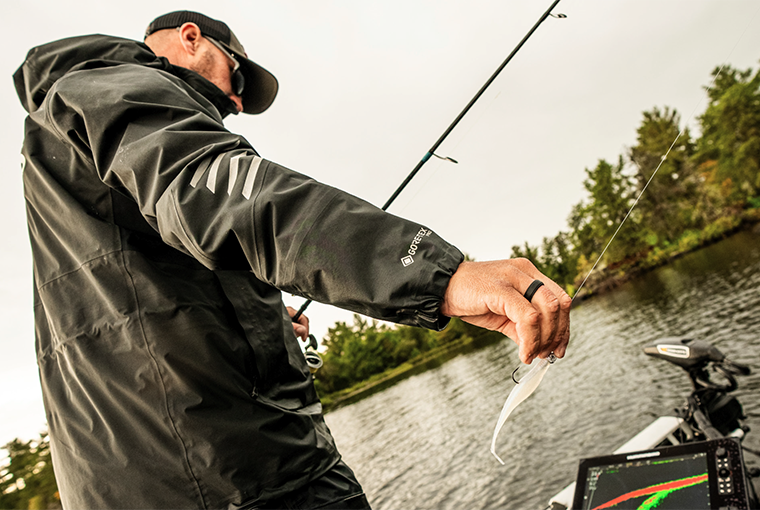
You can watch just about any bait throughout the retrieve with forward-facing sonar. I have watched bass strike jerkbaits, umbrella rigs, flutter spoons, and even topwaters, but I mostly rely on three finesse rigs that I use on spinning equipment.
As the 2023 tournament season drew to a close, some folks in the fishing community argued that forward-facing sonar was ruining bass fishing, giving us the ability to look at the entire water column and 100 feet or more out in front of the boat, revealing fish we never knew were there in the past. During competition, pro anglers can be seen with their heads down, looking at their screens for hours.
During nearly every outing this last season, I thought about how I wouldn’t have caught that fish if I didn’t have Humminbird’s Mega Live running at the bow. I see boulders, logs, weed clumps, and fish holding cover. I can spot individual fish swimming along and occasionally, even suspended fish that just seem to pop out of nowhere.
These are my top choices for throwing at bass I see on forward-facing sonar.
The minnow
When: A soft plastic jerkbait rigged on a jig head is my top choice for bass that are focused on eating baitfish. This is the same bait that I used for the moping technique that I have had success with at a few US tournaments in recent years. It’s the perfect minnow imitator. Rig it to match the size of baitfish in your body of water.
Usually, I’ll tie on a 3/8-ounce Smeltinator jig and attach a four-inch soft plastic bait. Make sure the bait is rigged up perfectly straight on the jog head. If the bait is bent or twisted, it won’t swim properly and will look unnatural. It will also twist your line. If I’m fishing shallower water or the fish are in the top of the water column I’ll use a lighter jig.
How to fish it: Watch your bait on the sonar. Cast it out and when it starts to fall, start reeling slowly to keep it a few feet above the fish. You want to get bass to swim and take a run at your bait. It’s tempting to want to put the bait right in front of them but always keep it above them and reel it slow and steady.
The Ned
When: It’s my top choice when targeting bass that I feel are feeding down on crayfish or gobies. The Ned rig consists of a jig head with a short piece of plastic worm threaded on to it. I’ll go with a 3⁄16-ounce jig head for water less than 10 feet, 1 ⁄4 ounce for 10- to 20-foot water, and 3⁄8 ounce for water over 20 feet. I want the bait to get to the bottom quickly, where the fish can find it. When you’re using forward-facing sonar, the benefit of the heavier jig head is it is easier to see.
How to fish it: Try not to drop the bait right on top of fish. Instead, land it a few feet away. One thing that you learn from using this technology is that bass can see your bait from a lot farther away than you think they can and landing the bait on their heads risks spooking them.
When you drop your Ned rig near a fish or fish-holding piece of cover like a boulder, let it hit the bottom and then shake it in place. Often the fish will swim over, have a look, and bite. If you don’t get their attention, snap your Ned rig off the bottom, then let it fall back. This can trigger bites.
The drop-shot
When: It works great anywhere bass swim, at all depths. This rig shines in clear water and around snaggy areas (particularly zebra mussels) because the rig naturally keeps the bait off the bottom. When the bite is really tough, the drop-shot is my go-to rig to pitch to fish on the screen. It’s the most finesse presentation in my boat. I’ll drop it to fish I see under the boat, and of course anytime I’m fishing really snaggy areas, it saves some jigs.
How to fish it: Like the Ned rig, put the dropshot next to fish or cover you see on the sonar and then let it naturally float and do its thing. The biggest mistake anglers make when fishing a drop-shot is they move and shake their rod too much.
Sometimes imparting no action is better than making the bait dance crazily.
Do you need forward-facing sonar to get out and catch a few fish? Absolutely not, but it will help you put your bait in front of more fish and see how they react to it. You learn that you won’t catch them all, but you’ll figure out new ways to trick a few into biting.
Originally published in Ontario OUT of DOORS’ Fishing Annual 2024






Leave A Comment